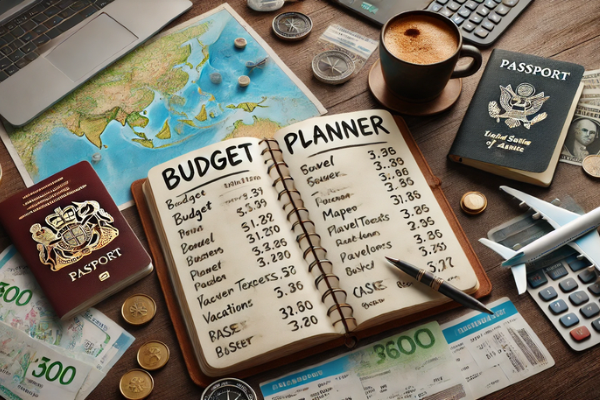Everyone needs a break now and then, and taking a vacation is one of the best ways to recharge and experience something new. But vacations can quickly go from relaxing to stressful if you overspend or return home with more debt than memories. The good news? With a clear, realistic budget, you can enjoy your time away without worrying about money.
In this guide, you’ll learn how to create a practical vacation budget that helps you plan ahead, avoid unnecessary expenses, and make the most of your getaway — all while keeping your financial goals intact.
Step 1: Define Your Vacation Goals
Before diving into numbers, take time to think about what kind of vacation you want. Are you looking for relaxation, adventure, cultural experiences, or time with family? Will you stay close to home or travel internationally? Knowing your priorities will help you create a budget that reflects what matters most to you.
Consider the following questions:
- Where do you want to go?
- How long will the trip be?
- Who is going with you?
- What experiences or activities are most important?
These decisions will shape your budget categories and help you spend intentionally instead of impulsively.
Step 2: Determine How Much You Can Afford
Next, look at your overall financial picture. How much money can you realistically set aside for your vacation without affecting your ability to cover monthly expenses or meet savings goals?
Instead of choosing a destination and trying to afford it, work the other way around: set your spending limit first, then build your vacation within that number. This approach prevents you from stretching your budget too thin or relying on credit cards to fill the gap.
Start by reviewing your current budget and determining how much you can save each month toward your trip. Set a target date and calculate how long it will take to reach your goal.
Step 3: Break Down the Costs
Once you know your total vacation budget, break it down into major spending categories. This will help you see where your money is going and avoid surprises.
Common categories include:
- Transportation: Flights, train tickets, car rentals, gas, parking, or rideshares.
- Accommodation: Hotels, vacation rentals, hostels, or campgrounds.
- Food and Drinks: Restaurants, groceries, snacks, and beverages.
- Activities and Entertainment: Tours, attractions, museums, shows, excursions, or amusement parks.
- Travel Insurance: Especially important for international travel or trips with non-refundable bookings.
- Souvenirs and Shopping: Gifts or personal purchases.
- Miscellaneous: Tips, baggage fees, toiletries, or emergency items.
Assign estimated costs to each category based on research, past experience, and your priorities. It’s better to slightly overestimate than to be caught off guard.
Step 4: Research and Compare Prices
Now that you’ve outlined your categories, take time to research real prices. Look up flights, lodging, transportation options, and activity costs. Compare prices across dates and platforms to find the best deals.
Being flexible with your travel dates or destination can also lead to significant savings. Traveling during off-peak seasons or midweek instead of weekends often reduces costs on flights and accommodations.
Use your research to adjust your estimates and finalize your budget numbers.
Step 5: Set Up a Dedicated Vacation Fund
To keep your vacation savings separate from your regular finances, create a dedicated savings account or envelope specifically for your trip. This makes it easier to track progress and resist the temptation to dip into the funds for other expenses.
Automate monthly contributions to this fund based on your goal and timeline. Even small, consistent deposits can add up over time and reduce the need to rely on credit later.
Step 6: Track Spending During the Trip
Your budget doesn’t end when the vacation begins — it travels with you. Track your spending each day or at the end of each activity to make sure you’re staying within your limits.
You can use a notebook, spreadsheet, or budgeting app to keep tabs on your expenses. The goal isn’t to be overly restrictive, but to stay aware of where your money is going and make adjustments if needed.
Step 7: Leave Room for Flexibility
No vacation goes exactly as planned. Build a little wiggle room into your budget for unexpected costs or spontaneous activities. A buffer of 5–10% of your total budget can help you handle last-minute changes without stress.
Also, if you spend less in one category (like skipping a restaurant meal or finding a cheaper tour), you can reallocate those savings to other areas of your trip.
Step 8: Avoid Debt-Based Travel
Using credit cards to pay for a vacation might seem convenient, but it can lead to long-term financial consequences. Paying off your trip over several months can result in high interest costs that far exceed the value of the experience.
Instead, focus on planning a trip you can fully afford before you go. If that means waiting longer or choosing a more modest destination, it’s worth it to travel with peace of mind.
Step 9: Evaluate and Learn After the Trip
Once you return home, take a few minutes to review your budget. Did you stay within your limits? Which areas did you overspend or underspend? What would you do differently next time?
This reflection helps you plan better future trips and reinforces the value of budgeting. It also gives you the opportunity to celebrate the fact that you enjoyed your vacation without compromising your financial health.
Final Thoughts: Enjoy More, Worry Less
Vacations should be joyful, not stressful. By creating a thoughtful, realistic budget and sticking to it, you can enjoy every part of your trip — from planning to returning home — without the burden of financial regret. Budgeting doesn’t mean you’re limiting the fun; it means you’re being intentional so you can focus on what really matters: the experience.
With a solid plan in place, you can travel confidently, spend wisely, and return feeling refreshed — not financially drained.
